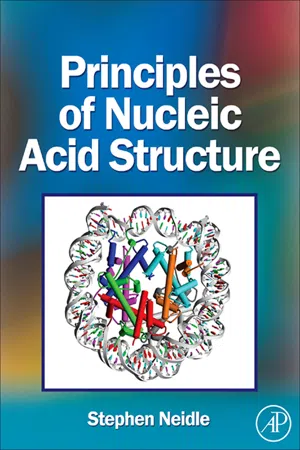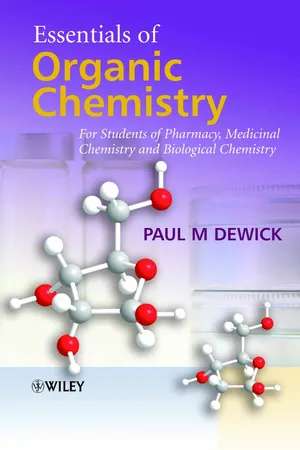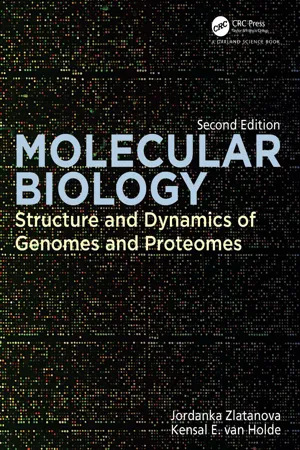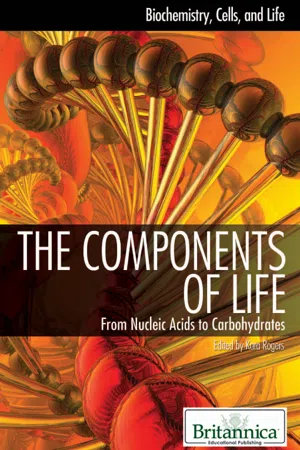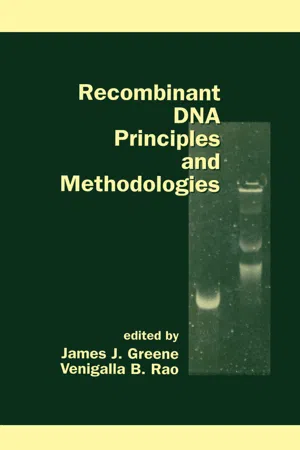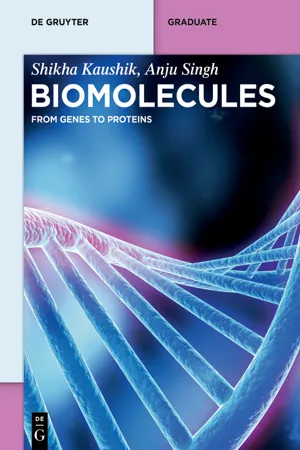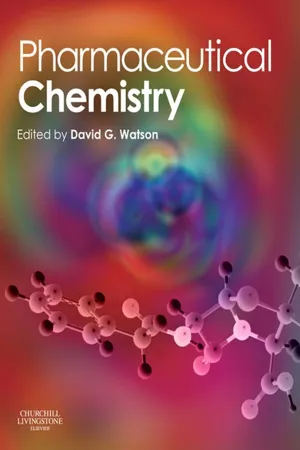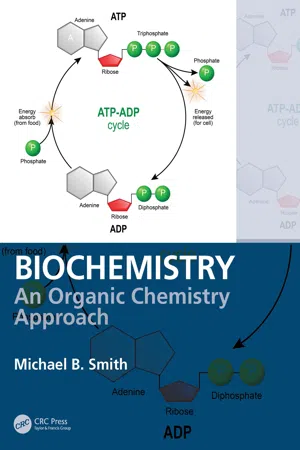Chemistry
Nitrogenous Bases
Nitrogenous bases are molecules that contain nitrogen and are essential components of nucleotides, the building blocks of DNA and RNA. There are four types of nitrogenous bases: adenine (A), thymine (T), cytosine (C), and guanine (G) in DNA, and adenine (A), uracil (U), cytosine (C), and guanine (G) in RNA. These bases pair up to form the rungs of the DNA double helix.
Written by Perlego with AI-assistance
8 Key excerpts on "Nitrogenous Bases"
- eBook - ePub
- Stephen Neidle(Author)
- 2010(Publication Date)
- Academic Press(Publisher)
2The Building-Blocks of DNA and RNA
Publisher Summary
Nucleic acid is composed of individual acid units termed nucleotides. Each repeating unit in a nucleic acid polymer comprises three units linked together—a phosphate group, a sugar, and one of the four bases. The bases are planar aromatic heterocyclic molecules and are divided into two groups—the pyrimidine bases thymine and cytosine and the purine bases adenine and guanine. Thymine is replaced by uracil in ribonucleic acids, which also have an extra hydroxyl group at the 2’ position of their (ribose) sugar groups. Individual nucleoside units are joined together in a nucleic acid in a linear manner, through phosphate groups attached to the 3’ and 5’positions of the sugars. Hence the full repeating unit in a nucleic acid is a 3’, 5’-nucleotide. Nucleic acid and oligonucleotide sequences use single-letter codes for the fiveunit nucleotides—A, T, G, C, and U. The two classes of bases can be abbreviated as Y (pyrimidine) and R (purine). Phosphate groups are usually designated as p.2.1 Introduction
Chemical degradation studies in the early years of the twenty-first century on material extracted from cell nuclei established that the high molecular-weight “nucleic acid” was actually composed of individual acid units, termed nucleotides. Four distinct types were isolated – guanylic, adenylic, cytidylic and thymidylic acids. These could be further cleaved to phosphate groups and four distinct nucleosides. The latter were subsequently identified as consisting of a deoxypentose sugar and one of four nitrogen-containing heterocyclic bases. Thus, each repeating unit in a nucleic acid polymer comprises these three units linked together – a phosphate group, a sugar, and one of the four bases.The bases are planar aromatic heterocyclic molecules and are divided into two groups – the pyrimidine bases thymine and cytosine and the purine bases adenine and guanine. Their major tautomeric forms are shown in Fig. 2.1 . Thymine is replaced by uracil in ribonucleic acids, which also have an extra hydroxyl group at the 2′ position of their (ribose) sugar groups. The standard nomenclature for the atoms in nucleic acids, as approved by the International Union of Biochemistry, is shown in Figs. 2.1 . and 2.2 . Accurate bond length and angle geometries for all bases, nucleosides and nucleotides have been well established by X-ray crystallographic analyses. Structural surveys (Clowney et al ., 1996;Gelbin et al ., 1996) have calculated mean values for these parameters (which define their equilibrium values) from the most reliable structures in the Cambridge and Nucleic Acid Databases. These have been incorporated in several implementations of the AMBER and CHARMM force fields widely used in molecular mechanics and dynamics modelling, and in a number of computer packages for both crystallographic and NMR structural analyses (Parkinson et al ., 1996). Accurate crystallographic analyses, at very high resolution, can also directly yield quantitative information on the electron-density distribution in a molecule, and hence on individual partial atomic charges. These charges for nucleosides have hitherto been obtained by ab initio quantum mechanical calculations, but are also available experimentally for all four DNA nucleosides (Pearlman and Kim, 1990 - eBook - ePub
Essentials of Organic Chemistry
For Students of Pharmacy, Medicinal Chemistry and Biological Chemistry
- Paul M. Dewick(Author)
- 2013(Publication Date)
- Wiley(Publisher)
14
Nucleosides, nucleotides and nucleic acids
14.1 Nucleosides and nucleotides
The nucleic acids DNA (deoxyribonucleic acid) and RNA (ribonucleic acid) are the molecules that play a fundamental role in the storage of genetic information, and the subsequent manipulation of this information. They are polymers whose building blocks are nucleotides, which are themselves combinations of three parts: a heterocyclic base, a sugar, and phosphate. The most significant difference in the nucleotides comprising DNA and RNA is the sugar unit, which is deoxyribose in DNA and ribose in RNA. The term nucleoside is used to represent a nucleotide lacking the phosphate group, i.e. the base-sugar combination. The general structure of nucleotides and nucleosides is shown below.Before we analyse nucleotide structure in detail, it is perhaps best that we consider the nature of the various component parts. In nucleic acid structures, there are five different bases and two different sugars.The bases are monocyclic pyrimidines (see Box 11.5 ) or bicyclic purines (see Section 11.9.1), and all are aromatic. The two purine bases are adenine (A) and guanine (G), and the three pyrimidines are cytosine (C), thymine (T) and uracil (U). Uracil is found only in RNA, and thymine is found only in DNA. The other three bases are common to both DNA and RNA. The heterocyclic bases are capable of existing in more than one tautomeric form (see Sections 11.6.2 and 11.9.1). The forms shown here are found to predominate in nucleic acids. Thus, the oxygen substituents are in keto form, and the nitrogen substituents exist as amino groups.The two sugars are pentoses, D -ribose in RNA and 2-deoxy-D -ribose in DNA. In all cases, the sugar is present in five-membered acetal ring form, i.e. a furanoside (see Section 12.4). The base is combined with the sugar through an N - eBook - ePub
Molecular Biology
Structure and Dynamics of Genomes and Proteomes
- Jordanka Zlatanova(Author)
- 2023(Publication Date)
- Garland Science(Publisher)
Figure 4.2 )—as well as a nitrogenous base and phosphate group(s). The base and sugar together form a nucleoside; depending on the number of phosphate groups attached to a nucleoside, it may be designated a nucleoside mono-, di-, or triphosphate. Nucleic acids are made of nucleoside monophosphates, shaded in blue, which contain Nitrogenous Bases that are derivatives of either pyrimidine or purine.The bases are all derived from either purine or pyrimidine, shown in Figure 4.1 . The kinds of bases found in nucleic acids are shown inFigure 4.2A. The basic groups contained in nucleic acids are always attached to the 1′-carbon of the sugar. Four different kinds are found in DNA: adenine (A), guanine (G), cytosine (C), and thymine (T). RNA contains the same bases except that uracil (U) substitutes for thymine. A ribose or deoxyribose with a base attached is called a nucleoside (Figure 4.2B). When a phosphate group is attached to the 5′-carbon of the sugar, a nucleotide, also called a nucleoside 5′-phosphate, is obtained (see Figure 4.1 ).Figure 4.2Nucleosides in RNA and DNA. (A) Chemical formulas of pyrimidines and purines. Uracil, shown in the box, is present only in RNA. (B) Differences between the nucleosides in DNA and RNA are highlighted in red. The table shows the nomenclature of nucleosides formed by the addition of each base to the respective pentose.As depicted inFigure 4.3A, the sugar moiety of nucleic acids is in the ring or β-furanose form. To a first approximation, we may say that four of the five atoms of the ring lie in the same plane; the position of the fifth atom, either C-2′ or C-3′, with respect to the plane determines whether the conformation is that of an endo nucleoside, with the fifth atom on the same side of the plane as the C-5′ atom, or an exo nucleoside, with the fifth atom on the opposite side of the plane. Actually the situation is more complex, with a variety of slightly different sugar conformations found. Nucleosides also have two conformations determined by the non-free rotation around the glycosidic bond (Figure 4.3B). The preferred conformation in nucleic acids is the anti conformation, in which the base and the sugar ring are as far away from each other as possible. As an example,Figure 4.3C - eBook - ePub
The Components of Life
From Nucleic Acids to Carbohydrates
- Britannica Educational Publishing, Kara Rogers(Authors)
- 2010(Publication Date)
- Britannica Educational Publishing(Publisher)
Nucleic acids, the amino acids of proteins, carbohydrates, and fatty acids all are naturally occurring chemical compounds. Each is also capable of being broken down to yield discrete components. For example, nucleic acids can be broken down into phosphoric acid, sugars, and a mixture of organic bases (purines and pyrimidines). Nucleic acids are the main information-carrying molecules of the cell, and, by directing the process of protein synthesis, they determine the inherited characteristics of every living thing. The two main classes of nucleic acids are deoxyribonucleic acid (DNA) and ribonucleic acid (RNA). DNA is the master blueprint for life and constitutes the genetic material in all free-living organisms and most viruses. RNA is the genetic material of certain viruses, but it is also found in all living cells, where it plays an important role in certain processes such as the making of proteins.NUCLEOTIDES: BUILDING BLOCKS OF NUCLEIC ACIDS
Nucleic acids are polynucleotides—long chainlike molecules composed of a series of nearly identical building blocks called nucleotides. Each nucleotide consists of a nitrogen-containing aromatic base (a stable organic compound) attached to a pentose (five-carbon) sugar, which is in turn attached to a phosphate group. Each nucleic acid contains four of five possible nitrogen-containing bases: adenine (A), guanine (G), cytosine (C), thymine (T), and uracil (U). A and G are categorized as purines, and C, T, and U are collectively called pyrimidines. All nucleic acids contain the bases A, C, and G; T, however, is found only in DNA, while U is found in RNA. The pentose sugar in DNA (2′-deoxyribose) differs from the sugar in RNA (ribose) by the absence of a hydroxyl group (-OH) on the 2′ carbon of the sugar ring. Without an attached phosphate group, the sugar attached to one of the bases is known as a nucleoside. The phosphate group connects successive sugar residues by bridging the 5′-hydroxyl group on one sugar to the 3′-hydroxyl group of the next sugar in the chain. These nucleoside linkages are called phosphodiester bonds and are the same in RNA and DNA. Without an attached phosphate group, the sugar attached to one of the bases is known as a nucleoside. The phosphate group connects successive sugar residues by bridging the hydroxyl (hydrogen and oxygen) group at the 5′ position on one sugar (see diagram) to the position 3′-hydroxyl group of the next sugar in the chain. These nucleoside linkages are called phosphodiester bonds and are the same in RNA and DNA.Portion of polynucleotide chain of deoxyribonucleic acid (DNA). The circles indicate phosphate groups, which are made up of three oxygen (O) molecules surrounding one phosphate (P) molecule. Each phosphate group is attached to a pentose (five-sided) sugar. In DNA, this sugar is called deoxyribose. The phosphate-sugar group is then joined with one of four nitrogen (N)-carrying bases, which are either purine or pyramidine molecules. The inset shows the corresponding pentose sugar called ribose and the pyrimidine base uracil in ribonucleic acid (RNA) - eBook - ePub
- James Greene(Author)
- 2021(Publication Date)
- CRC Press(Publisher)
2Biochemistry of Nucleic Acids
Paul S. Miller Johns Hopkins University, Baltimore, MarylandI. CHEMICAL STRUCTURE AND PROPERTIES OF NUCLEIC ACIDS
A. Chemical Structure
Nucleic acids are high molecular weight macromolecules that form the genetic material of all living organisms. Two types of nucleic acids are generally encountered: deoxyribonucleic acid (DNA) and ribonucleic acid (RNA). DNA serves as the repository for genetic information for both procaryotes and eucaryotes. RNA serves a functional role in the conversion of genetic information into cellular proteins, and in the case of certain viruses it serves as the genetic material as well.The nucleic acids can be considered as polymers of deoxyribo- or ribonucleotides. The basic structures of DNA or RNA in their single-stranded forms and the numbering system used to designate the various atoms are shown in Figure 1 . Each nucleotide unit is composed of a nitrogenous heterocyclic base, a sugar residue, and a phosphate group. The heterocyclic bases are either six-membered pyrimidine rings or nine-membered purine rings. Two types of purines and two types of pyrimidines are found in nucleic acids. Both DNA and RNA contain the purines adenine and guanine. DNA contains the pyrimidines cytosine and thymine, whereas RNA contains the pyrimidines cytosine and uracil. In addition to the four common bases, RNA also contains a number of unusual bases such as 4-thiouracil, thymine, 7-methylguanine, 6, 6-dimethyladenine, and hypoxanthine. These unusual bases are generally found in transfer RNA (tRNA) and in mRNA. With the exception of 5-methylcytosine, DNA contains almost exclusively the four common heterocyclic bases.The heterocyclic bases are linked to the sugar via an N-glycosyl bond. The resulting compound is called a nucleoside. Nucleosides found in DNA contain D-2′-deoxyribose sugars in the furanose form, whereas those in RNA contain D-ribose sugars in the furanose form. In order to distinguish between atoms in the heterocyclic base and atoms in the sugar, the sugar atoms are given numbers with primes (Figure 1 - eBook - ePub
Biomolecules
From Genes to Proteins
- Shikha Kaushik, Anju Singh(Authors)
- 2023(Publication Date)
- De Gruyter(Publisher)
The versatility and elegant simplicity of DNA (deoxyribonucleic acid) double helix dictate life. Although, nucleic acid was first identified as ‘nuclein’ by Friedrich Miescher, a Swiss physician and biologist in 1869, yet it took more than 70 years to demonstrate that it is the molecule that carries genetic information. DNA of a single cell contains all genetic information necessary for processes of life. The double-helical structure of DNA was discovered by James D. Watson and Francis H. C. Crick in 1953, using the X-ray diffraction data of Rosalind Franklin, and this marvelous discovery proved to be the significant turning point that paved the way to the development of biomedical science and modern biology. Structurally, DNA is a flexible molecule which can adopt numerous unusual structures depending on the solution conditions. To understand the structure of B-form of DNA (natural/native form), it is important to understand the individual components of DNA. Nucleic acids (DNA and RNA (ribonucleic acid)) are long linear polymers which are made up of monomer units called nucleotides. All nucleotides are made up of three components: a nitrogen heterocyclic base, a pentose sugar, and a phosphate group. They are termed as nucleic acids because they are found in nucleus and comprise phosphoric acid (phosphate) as one of its components. The two types of nucleic acids that occur in cells are DNA and RNA. DNA acts as a carrier of genetic information and is found in the nucleus of the cell, whereas RNA is present in both the nucleus and cytoplasm.5.1 Components of Nucleic Acids
Both DNA and RNA are biopolymers, which are made up of monomer units called nucleotide. Nucleotide is the building block of nucleic acids which consists of three components:- pentose sugar
- nitrogenous base
- inorganic phosphate
5.1.1 Pentose Sugar
It is of two types:- Deoxyribose
- Ribose
In DNA, the pentose sugar is 2ʹ-deoxyribose, whereas in RNA, it is ribose where hydrogen at the 2ʹ-position is replaced by the hydroxyl group. Why primes? The carbon atoms in sugars are numbered as 1′, 2′, and so on, to differentiate them from atoms of Nitrogenous Bases. The chemical structures of these two sugars are shown in Figure 5.1 .Figure 5.1: Structure of sugars.5.1.2 Nitrogenous Bases
Two types of Nitrogenous Bases present in nucleic acids are monocyclic pyrimidines and bicyclic purines. The two purine bases found in DNA and RNA are adenine (A) and guanine (G). Adenine has an amino group (-NH2 ) at the C-6 position of purine ring and guanine has an amino group (-NH2 ) at C-2 position and carbonyl group (-C = O) at C-6 position. The pyrimidine bases present in DNA are thymine (T) and cytosine (C), whereas uracil (U) is found in RNA, in place of thymine. Thymine contains a methyl group (-CH3 ) at the C-5 position with carbonyl group (-C = O) at C-2 and C-4 positions. Cytosine contains a carbonyl group at C-2 with an amino group at C-4, whereas uracil contains carbonyl group (-C = O) at C-2 and C-4 positions (Figure 5.2 ).Figure 5.2: Structure of Nitrogenous Bases: purines (adenine and guanine) and pyrimidines (cytosine, thymine, and uracil).5.1.3 Inorganic Phosphate
Phosphate group in nucleic acids is derived from phosphoric acid, and is attached through the oxygen atom of hydroxyl group of the 5′-carbon of the pentose sugar. At physiological pH, inorganic phosphate exists primarily as a nearly equal mixture of dihydrogen phosphate and monohydrogen phosphate. Thus, phosphate solution functions as effective buffer at pH 7.4. - eBook - ePub
- David G. Watson(Author)
- 2011(Publication Date)
- Churchill Livingstone(Publisher)
Fig. 7.18 ).Figure 7.18 The pyrimidine base, uracil, and its associated nucleoside and nucleotide.Self Test 7.4Draw the structure of the uridine:adenosine base pair.Whilst the chemical distinctions between the nucleic acids may be small, their structural and functional differences are more significant. Whilst DNA may be responsible for storing the genetic code, in order to turn the genetic information into a protein two steps are required: transcription and translation. During transcription the template of the DNA is used to produce messenger RNA (mRNA) and the mRNA template is used to assemble a protein using transfer RNA (tRNA) which literally fetches the amino acids coded for by the mRNA. These are then used to assemble the peptide chain (see Ch. 6 ). Table 7.1 shows the genetic code triplets in RNA corresponding to the different amino acids used to assemble peptides.Table 7.1 Three base codons used to code for the 20 amino acids found in proteins
Table 7.1Amino acid Codes Glycine GGU, GGC, GGA, GGG Alanine GCU, GCC, GCA, GCG Serine UCU, UCC, UCA, UCG, AGU, AGC Proline CCU, CCC, CCA, CCG Valine GUU, GUC, GUA, GUG Threonine ACU, ACC, ACA, ACG Cysteine UGU, UGC Leucine CUU, CUC, CUA, CUG, UUA, UUG Isoleucine AUU, AUC, AUA Aspargine AAU, AAC Aspartic acid GAU, GAC Glutamine CAA, CAG Lysine AAA, AAG Glutamic acid GAA, GAG Methionine AUG Histidine CAU, CAC Phenylalanine UUU, UUC Tyrosine UAU, UAC Arginine GCU, CGC, CGA, CGG, AGA, AGG Tryptophan UGG - eBook - ePub
Biochemistry
An Organic Chemistry Approach
- Michael B. Smith(Author)
- 2020(Publication Date)
- CRC Press(Publisher)
There are derivatives that have one or two nitrogen atoms at different positions in bicyclic six–six, six–five, or five–five fused aromatic rings. It is also possible to incorporate three, four, or even more nitrogen atoms into these rings. An important six–five heterocyclic ring system that contains four nitrogen atoms is called purine, and derivatives of this fundamental heterocycle include adenine and guanine, which are components of deoxyribonucleic acid (DNA) and ribonucleic acid (RNA), discussed in Section 15.2.There are five particularly important nucleosides derived from d-ribofuranose. There are two purine derivatives, adenosine with an adenine unit on the ribose and guanosine with a guanine unit on the ribose. There are three pyrimidine derivatives, uridine with an uracil unit, cytidine with a cytosine unit, and thymidine with a thiamine unit. There are also important deoxyribofuranose derivatives formed by using a ribose unit without an OH at C2. Purine derivatives include 2′-deoxyadenosine and 2′-deoxyguanosine. Pyrimidine derivatives include 2′-deoxyuridine, 2′-deoxycytidine, and 2′-deoxythymidine. The bases found in DNA and RNA are listed in Table 15.1 , along with their one-letter codes. The ribofuranose derivatives are the monomeric units found in RNA and the 2′-deoxyribofuranose derivatives are the monomeric units found in DNA (deoxyribonucleic acids).Table 15.1One-Letter Codes for Heterocyclic AminesHeterocycles (Bases, Β)Structure One-Letter Code Adenine A Guanine G Uracil U Cytosine C Thymine T Each nucleotide can react with phosphoric acid or a phosphoric acid derivative to form a phosphate ester. The phosphate ester of a nucleoside is called a nucleotide . Using adenosine derivatives as an example, there are three possible monophosphate esters, adenosine 5′-monophosphate, adenosine 3′-monophosphate, and adenosine 2′-monophosphate.A nucleotide with a second attached phosphate unit is a diphosphate (e.g. adenosine 5′-diphosphate), and a third phosphate unit is seen in adenosine 5′-triphosphate. These three compounds have abbreviations that are commonly used. The monophosphate is abbreviated AMP, the diphosphate is ADP, and the triphosphate is ATP. These abbreviations stem from a one-letter code for each heterocycle used to form the nucleotide, in this case A for adenine (see Table 15.1
Index pages curate the most relevant extracts from our library of academic textbooks. They’ve been created using an in-house natural language model (NLM), each adding context and meaning to key research topics.
Explore more topic indexes
Explore more topic indexes
1 of 6
Explore more topic indexes
1 of 4
